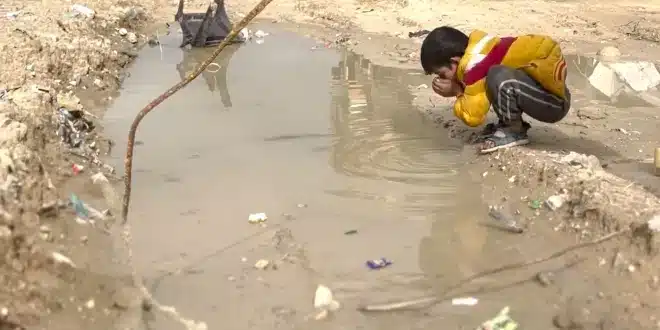Two soldiers, dressed in green tactical gear and black combat boots, were seen wiring explosives to pumps at the Canada Water reservoir in Rafah, southern Gaza. Shortly after, an explosion sent flames and smoke into the sky, severely damaging the critical water facility. This incident, captured in a now-deleted video reportedly shared by an Israeli soldier on Instagram and later geolocated by CNN, occurred between July 26 and July 27. Satellite images confirm the destruction, with visible damage to nearby buildings.
The Canada Water reservoir, which had the capacity to hold 3 million liters of water, was a key component in providing water to 150,000 people in the Rafah Governorate before the war began on October 7, according to the UN’s Office for the Coordination of Humanitarian Affairs (OCHA). When questioned about the video, the Israel Defense Forces (IDF) stated that their troops were active in the Tal al-Sultan area for several weeks, focusing on dismantling terrorist infrastructure while attempting to minimize damage to civilian structures. The IDF also mentioned that the incident is under review by the Fact Finding and Assessment Mechanism, an independent body that investigates exceptional events in warfare.
The destruction of water facilities in Gaza, as reported by the UN and other international bodies, has exacerbated the suffering of civilians, increased the risk of disease, and led to accusations against Israel of using water supply as a weapon of war. The destruction of the Canada Water reservoir is seen as a violation of international humanitarian law, according to Mark Zeitoun, director general of the Geneva Water Hub, which specializes in hydro-diplomacy.
Even before the explosion, Rafah’s mayor, Ahmed Al-Sofi, noted that the Israeli siege had already drained fuel and electricity needed to operate water systems, leading to severe shortages. Al-Sofi described Rafah as a city suffering from destruction, hunger, and thirst. The availability of water in Gaza has drastically declined, with Oxfam reporting that residents had access to just 4.74 liters of water per person per day in July, far below the emergency minimum.
The extreme summer heat has worsened the water crisis for Palestinians, who are already dealing with food scarcity and frequent displacement. The Israel Meteorological Service recorded this June as the hottest on record, adding further strain to the population. The UN reports that Israel’s war efforts have significantly reduced the availability of fuel, chlorine, and essential parts needed for water production and sanitation in Gaza. Around 70% of water and sanitation facilities in Gaza have been destroyed or damaged.
Israel’s COGAT agency, responsible for aid approvals, stated that it allows unlimited entry of water tanks and fuel into Gaza and has been facilitating repairs to water infrastructure. However, many Palestinians reported to CNN that they face dangerous journeys to access water, risking exposure to Israeli attacks. Some have witnessed violence at public distribution points as people fight over scarce resources. In makeshift camps, sewage overflows into the streets, and children are drinking from puddles.
Gaza’s Ministry of Health has recorded over 1.7 million cases of infectious diseases, including a recent polio case that left a 10-month-old child paralyzed. The WHO has found the polio virus in sewage samples, putting thousands at risk. The ongoing conflict has hindered vaccination efforts, leading the WHO to call for a halt in fighting to allow a vaccination campaign.
Alaa Riyad, a widower from Beit Lahia, described the daily struggle to find water, often discovering worms in the supply. Since his wife and 18 relatives were killed in an Israeli bombardment, he has taken on the role of both father and mother to his children, enduring the harsh conditions.
The conflict in Gaza has claimed over 40,200 Palestinian lives and injured around 93,000, according to Gaza’s Health Ministry. The war began after Hamas attacked southern Israel on October 7, killing around 1,200 people and taking more than 250 hostages.
Gaza’s water crisis has been decades in the making. In 2017, UNICEF declared 95% of water from Gaza’s sole aquifer unfit for consumption due to over-extraction and contamination. In 2021, most of Gaza’s water came from groundwater wells, with the rest supplied by desalination plants and Israel’s national water company. Since the early summer, however, municipal wells and desalination plants have been operating at a fraction of their capacity.
Wim Zwijnenburg, a conflict environmental impact expert from the Dutch peace organization PAX, told CNN that the damage to Gaza’s water infrastructure is the most severe he has seen in over a decade. The destruction of water systems, including pumping stations, wells, and piping, leaves the population with no choice but to drink unsafe water.
Saaed Al-Madhoun, an emergency response manager for CARE International, fled his home in Gaza City during the conflict and now struggles to provide water for his family in Deir al-Balah. He described the dire conditions, with his family surviving on just 20 liters of water per day—far below the minimum needed for survival.
The ongoing Israeli attacks have further strained Gaza’s already crippled water infrastructure, with devastating consequences for the population.


